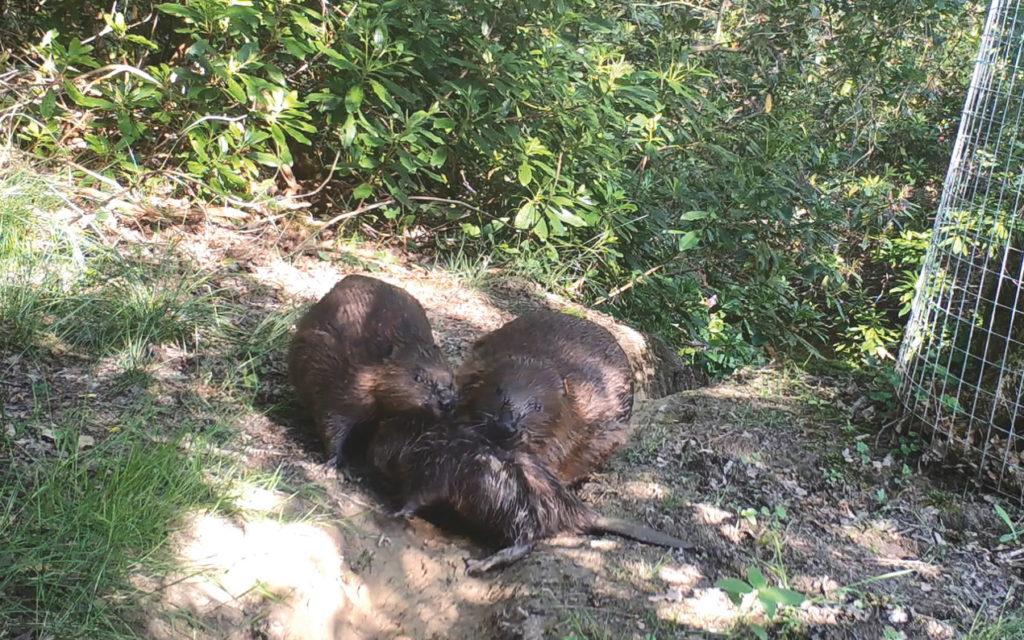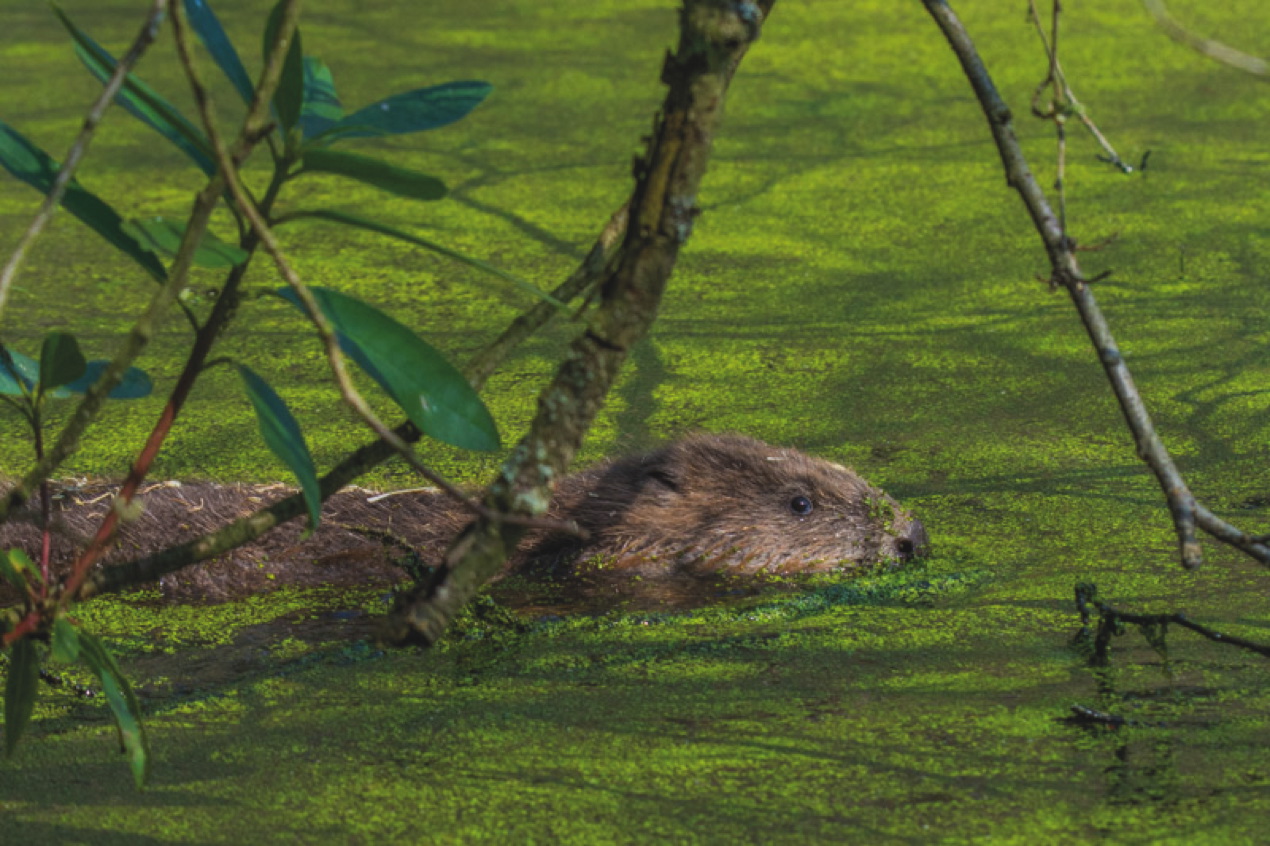Who gives a dam?
Loved by many but loathed by others, beavers’ reintroduction to the British countryside after an absence of four centuries is not without controversy or opposition
Deep within one of the thickest, darkest forests in Yorkshire a fascinating experiment is in progress. A couple of beavers have been, well, doing what they do best and beavering away at building dams over streams with piles of sticks.
It is less than two years since a male and female beaver were let loose in this part of the North York Moors. They made themselves at home by producing a couple of offspring – known as kits – during their first summer there, and this month the female has given birth to a third.
The sanctuary has been secured with fences so they can’t escape onto neighbouring farmland
Their famous dams have been constructed on a tributary stream of the River Severn, which drains a remote area of the vast Cropton Forest. It is too early to say if this five-year trial use of natural flood management is responsible for slowing the flow downstream to the village of Sinnington, which has suffered several floods in past decades. But those behind the beaver project believe the animals have played a part. Certainly, another beaver reintroduction scheme on the River Otter in Devon has confirmed that the dams really do hold back water from previously flooded communities.
But bringing back beavers is not just about reducing flood risk. It is also about the benefits that the ponds and lakes created by their dams can have for insects, birds, amphibians and bats. Which is why the Yorkshire trial is being closely watched by wildlife trusts in Derbyshire, Lancashire, Cumbria, Northumberland and Wales.
Reintroducing beavers is not without controversy, however. Farming and angling groups are opposed to beavers being allowed unimpeded access to rivers and streams. In Scotland, beavers are a particularly thorny issue. Released on the upper reaches of the River Tay 15 years ago, at the last count there were more than 450 of them. Although they are popular with the public, farmers and landowners claim their dams have flooded fields. Consequently, last year 87 beavers were shot under licenses issued by Scottish Natural Heritage (SNH) despite Scotland’s parliament making beavers a protected species.
SNH says beavers can seriously compromise the ability of farmers to produce crops or rear livestock in low-lying fields that rely on good drainage. As well as culling, they have tackled the problem by installing specially designed beaver-proof fencing and re-engineering riverbanks near productive fields to make them harder for beavers to use.
At Cropton Forest, though, the beavers are seen in a more positive light, which is hardly surprising given that the landowner, Forestry England, is in charge of the re-introduction experiment. They were released into an area the size of 10 rugby fields that includes two old ornamental fish ponds as well as a natural stream. The sanctuary has been secured with fences so they can’t escape onto neighbouring farmland.

Cath Bashforth, Forestry England’s ecologist in Yorkshire, describes beavers as “natural habitat engineers” because they have created a complex wetland at Cropton that wouldn’t otherwise have been possible. This has provided a new habitat for species of wildlife that had declined in area, whilst also slowing the flow of water downstream.
“There’s definitely more amphibians there,” she says. “And with so many frogs and toads the ponds have attracted 12 herons. We’ve even captured on film a tawny owl catching a toad, while we’re getting otters sighted more often because there’s more water.”
There is currently no public access to the beaver enclosure but in a year or so Forestry England may allow beaver watching limited to small groups. However, a wider eco-tourism facility is seen as unlikely, says Bashforth. “The thing is we want the beavers to behave as naturally as possible. We don’t want them to be intimidated by crowds of people.”
The flood alleviation aspect of the beavers’ release is being studied by scientists from Exeter University to assess whether it could help other flood-hit communities in the UK. They are also involved in England’s biggest existing beaver re-introduction project currently taking place in the West Country.
Devon Wildlife Trust released two breeding pairs of beavers from Bavaria onto the River Otter in 2015, and there are now thought to be about 13 family groups. “After five years we’ve learned an awful lot,” says the trust’s chief executive Harry Barton. “For example, we’re dealing with a wild animal so you can’t completely control it and can’t be absolutely certain that beavers will do what you want and go where you want. But taking that into consideration they bring huge benefits, and the negative aspects can usually be managed.”
Barton describes the beaver as a “keystone species”, which in conservation terms means they exercise the dominant influence on the habitat they occupy, and so are vital to the wellbeing of other wildlife.
For the general public, seeing the mammals there can be hit and miss. At the start of the Devon project the beavers built their lodges near to where there was good access, and a lot of people went out on summer evenings to see them. But eventually this scared off the beavers and they are now building their lodges in places that are harder to reach.
Barton says: “Most locals know where they can see them. People have been really responsible and followed the advice we’ve put up on red signs.” But the beavers have not been so popular with some farmers, and to address their concerns the trust has set up a “beaver hotline”.
Another conservation group hoping to re-introduce beavers is Derbyshire Wildlife Trust. It is currently running a public appeal for funds to establish a beaver colony at its Willington Wetlands reserve, an old quarry in the Trent Valley. It has so far raised £125,000 to pay for the fencing – working out about £5 per foot – but requires the same amount again to bring beavers over from Bavaria.
The trust’s Ben Carter says: “People are really enthused by watching wildlife from home, as we’ve seen during lockdown, and beavers are ideal for that on webcams.”
Looking ahead, he adds that it might be possible for beavers to help with slow-the-flow work in the Upper Derwent Valley to the west of Sheffield, which may reduce the flood risk at places like Matlock.
Earlier this year an organisation called the Cumbria Beaver Group, which includes conservationists like Cumbria Wildlife Trust and the RSPB, was granted a licence to begin a re-introduction project on the Lowther Estate near Penrith. As in the North York Moors and Derbyshire these beavers will not be free-roaming. But the re-introduction is on hold due to the coronavirus emergency.
Northumberland Wildlife Trust is also working with landowners to find suitable sites for beavers, since the trust doesn’t have any reserves that would accommodate the animals. Its chief executive Mike Pratt says that beavers could help restore some streams and rivers there.
However, in recent months the Department for Environment, Food and Rural Affairs has indicated it may slow down the process of further reintroductions. This is because the National Farmers’ Union and landowners have voiced concerns about the impact of free-roaming beavers on rivers, even though that is how they lived when they were a native British species nine centuries ago. So for the foreseeable future, it looks like English beavers will have to live with fences.
Until recently beavers were one of the missing pieces in the UK’s wildlife jigsaw.
Once common in Britain, this large rodent with distinctive flat tail and webbed feet created countless lakes, ponds and wetlands in the upper reaches of rivers by building dams to deepen watercourses. This enabled them to construct their homes, known as lodges, with underwater entrances to keep them safe from predators like foxes.
However, they were hunted for their meat and high-quality fur, while their scent glands were prized because of a secretion called castoreum, which they used to mark out territories. Castoreum from foreign beaver populations is still added as a vanilla-like flavouring to some ice creams, cakes and chewing gum, and is an ingredient of some perfumes.
The last beavers in England and Wales were seen in the 12th century, but they survived in remoter parts of Scotland until the 1500s. They were persecuted throughout Europe, and although they fared better on the Continent than in the UK they had been virtually wiped out by the turn of the 20th century. Today they survive in eight areas, with the biggest population – estimated at 14,000 – in the German region of Bavaria.
Beavers seen in the Tayside area of Scotland around 2006 were thought to have escaped from a private collection. Their successful breeding prompted a trial re-introduction in the Knapdale area of Kintyre a few years later, and two beavers from that population were released in the North York Moors in late 2018. Beavers reintroduced to Devon and Cornwall are from Bavaria.

Leave a reply
Your email address will not be published.